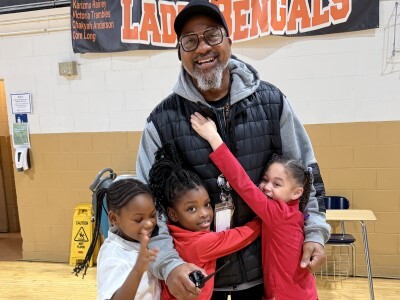Educator Networks: Building a Community to Advance Learning
Topics

When educators design and create new schools, and live next gen learning themselves, they take the lead in growing next gen learning across the nation. Other educators don’t simply follow and adopt; next gen learning depends on personal and community agency—the will to own the change, fueled by the desire to learn from and with others. Networks and policy play important roles in enabling grassroots approaches to change.
The Bill & Melinda Gates Foundation and FSG collaborated to release a new report that provides practitioners an opportunity to reflect on what we think we know about network design and theory and how we apply it in education.
Are you one of the 1200+ people considering a response to the new Gates RFP: Networks for School Improvement? If so, you might be interested to learn that FSG (commissioned by the Bill & Melinda Gates Foundation) recently released a relevant and timely report: The Role of Networks in Advancing Personalized Learning. The common denominator—“networks”—is not a new notion, but these developments provide an opportunity to reflect on what we think we know about network design and theory and how we apply it in education. For example, what purposes do networks serve? Can a network really be considered healthy? What might make a network “powerful” in generating educational change or effect?
Roles of Networks in Supporting Change
FSG’s report maps the interconnections within and between network roles to advance the current state of personalized learning—a still emerging and innovative approach for embracing every student’s individual learning profile. Like so many of us working in spaces not yet well established and characteristically messy, I appreciate the descriptive framework and diversity of examples included. FSG illustrates how networks can advance models, shift practice, support evidence-building, and engender democratic values. Their intent is to help us see ways of strengthening our networks and identify beneficial next steps.
In the spirit of equitable learning design and using the frame of personalized learning, FSG outlines five influential and interrelated roles networks play.

I don’t think these roles are specific to personalized learning. I think they can apply to efforts advancing any kind of positive change in K-12 education such as project-based learning, STEM, or competency-based learning. Looking at the diagram, it’s easy to envision the efforts of popular national networks like New Tech Network and Big Picture Learning supporting the spread of promising practice and providing pathways to scale. As acknowledged in the report, network designs are a flexible alternative to traditional top down “command and control” methodologies for achieving scale. FSG shows how networks allow for variables in local context, and diverse approaches that share a common purpose. And how networks enable educator-owned designs, peer sharing, and conditions conducive to learning in community.
The resulting relationship bonds help sustain innovation and bolster resiliency of participating members and organizational initiatives. I’ve seen this in my work with NGLC’s networks of educators. Individuals have repeatedly shared that their connections, through our network, to peers across the country keeps them from feeling isolated, inspires their curiosity for continuous learning, and supplies fresh ideas and peer support for solving unexpected challenges such as leadership turnover or changes in policy and funding priorities.
Quality of Networks in Leading Change
While most network examples share unifying content (the what), the magic of the network might be more likely found in the how. How the network functions, the intentionality of culture and conditions, the quality of interactions and exchanges. Participating in networks for leaders of next gen learning can mean engaging in work processes and community norms that align with the values and principles we hold for and with student learning—it can be collaborative, co-creative, autonomous, trusting, and equitable. The process accurately reflects (and helps to fulfill) the goals.
These conditions are nurtured intentionally through relationships fostered in meaningful work and a balance of giving and receiving support. Said another way, networks can facilitate an experience that is more than mechanical or technical in nature. It’s really about building community. These are notions I’m learning myself from the work of Curtis Ogden of the Interaction Institute for Social Change. FSG engaged Ogden early on in its study as a thought leader and resource for the field and NGLC is continuing to work with him to stretch our thinking today.
Activate Your Networks to Create Change
So, what does this mean for you? Insights from a report only become meaningful when we do the hard work of reflecting on our own practice and applying the lessons to our own work.
- Whether or not you intend to apply for the latest Gates grant, whether or not you are focused on personalized learning, I encourage you to explore how your networks might, as FSG suggests, “complement and amplify” related work in your own school or organization. How might you engage in your network differently to take advantage of this effect? Are you already clear on the network role(s) being served?
- If you lead a network, the idea that quality connections might determine or signify “health” makes intuitive sense. You also know it’s much easier said than done. What do you consider indicators of “network health”? How would you describe the culture of the network or the effects enabled by that culture? Here’s some inspiration:
“The most robust and resilient networks are those that create additional value for each participant while strengthening a community or ecosystem as a whole.”
–Adam Pattantyus, quoted in Networks, Return-On-Investment and Co-Creation by Curtis Ogden
- FSG’s report asks us: How can we make the implicit work of networks more explicit? What values do we prioritize? How do we affiliate with supporting entities such as funders and/or outside networks? What contributes to our knowledge creation and meaning-making? Does evaluation play a role? The role-identified questions provided in the report are important reflections for anyone committed to growing the potential of personalized learning for their organizations, educators, and students
This focus on networks can benefit all of us as we seek to make system-level shifts in how we do what we do, and as we continue to shift from top-down directives to more self-directed, co-creative communities embodying learning and change. I am particularly interested in how networks can shift the way we create the social change toward more equitable learning designs. NGLC intends to continue this conversation by sharing what we’ve learned, where we’ve made some mistakes, and what inspires us from networks in and outside education. See our Networks for Learning site to learn more.




